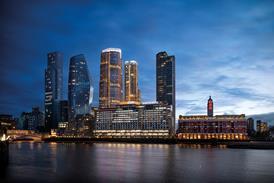Joe Dwyer talks to us about his 50 years in construction, the ÂŁ2bn regeneration of his home town Liverpool, the axing of Alsopâs Fourth Grace, the night he almost died and why he is like JosĂ© Mourinho â whereas Sir Neville Simms isnât.

Tick, tock, tick, tock. Decision time is fast approaching for Merseysideâs urban regeneration company. This autumn, the board of Liverpool Vision will either ask Sir Joe Dwyer to take up a third term as its chairman â unprecedented for a regeneration company â or it will call time on a 50-year career in construction. After meeting Dwyer in person, you get the feeling that they ought to think very carefully about which they choose âŠ
âWhat would I do if I retire? Perhaps Iâd work on my golf handicap, but I donât like the word âretirementâ,â he says. With his Clint Eastwood squint and dry Scouse delivery, Dwyer gives the impression of being as tough as old boots. He is, he says, âan unemotional manâ. Nevertheless, he badly wants to retain his place at Liverpool Vision, and he doesnât shift easily, as his career shows.
Dwyer started out at 16, producing work schedules at a Wimpey site in Liverpool. He carried on working for the company until 1999, ending up as chief executive and chairman. His career with Wimpey made him one of the most highly regarded executives in the construction industry. This reputation was sealed forever when he pulled off one of the most audacious coups of the 1990s, by getting the better of a ÂŁ700m asset swap deal with Tarmac, led by his old rival Sir Neville Simms. This transformed Wimpey from a contractor making a pre-tax profit of ÂŁ15m to a housebuilder making ÂŁ451m last year. It also destroyed Tarmac in the form it was in.
The Wimpey years Dwyer and Simms have followed similar career paths. Both worked on the Channel Tunnel, and both were instrumental in shaping their companies. However, as personalities, they could hardly be more different â Simms loved to play the captain of industry on the public stage; Dwyer, was seen as a figure of immense integrity and loyalty to Wimpey, but would always prefer not to talk to the press if it could be avoided. I suggest that they are a bit like Arsene Wenger and Sir Alex Ferguson. âWell, Iâd probably be JosĂ© Mourinho,â he says. âWimpey has half a billion profits and is probably the biggest housebuilder around. Neville would be âŠ
Iâd rather not say. If you asked Neville Iâm sure he would admit that he didnât really want the contracting business. Neville and I are good friends, though. He gave me the retirement dinner when I left Wimpey.â
The reasons underlying the swap were simple: Dwyer had reached the conclusion that contracting was a mugâs game. âWhat chief executives never do is admit that their strategy had been wrong.
I did. Contracting is a no-asset business. I calculated that with overheads, it probably didnât make any money. High risk, no reward. The catalyst was when we lost out on a terminal building for Hong Kong airport. I realised if we had won it and something had gone wrong, weâd have lost lots of money. The only thing in Wimpey making proper profits was housebuilding. Our last results as a conglomerate were ÂŁ15m.
Arbuthnot analyst Stephen Rawlinson takes a more nuanced view. âHistory canât properly judge if the deal was a good one or not, because of the way the businesses have been broken up,â he says. âFor a Wimpey shareholder the benefits have only recently come through.â
The hint is that it was under Peter Johnsonâs stewardship that Wimpey really took off. Dwyer argues that the firm has simply taken advantage of the booming housing market since he left â and it was his deal gave them the platform to do that. Now the market has started to go south, Wimpey has started to struggle.
Steve Morgan, a fellow Scouser and the founder of Redrow Homes, is more respectful of Dwyerâs record. âHeâs a really, really nice man, is Joe. A really good operator,â he says.
The Vision thing
After leaving Wimpey, Dwyer was called in to tackle the regeneration of Liverpool. This was a job for a really good operator if ever there was one: Liverpool had suffered the steepest decline of any urban area in Europe: its population has fallen from E
What would I do if I retire? Perhaps Iâd work on my golf handicap, but I donât like the word âretirementâ
E 1 million to 400,000, and in the process it became a byword for unemployment, crime and bad playwrighting. Dwyer assembled a heavyweight board to help him, including Sir Terry Leahy, the boss of Tesco, and website entrepreneur Matt Johnson. Itâs these kind of private sector leaders that Dwyer believes will deliver public sphere projects. But how did he persuade Leahy â arguably Britainâs most successful executive â to join him? âI knew Terry previously â weâre both Liverpudlians. He told me his family still lived up here. So he comes up for Friday afternoonâs board meetings and sees his mother and family.â
Liverpool Vision was formed in 1999 after the government decided that the council was not capable of delivering large-scale regeneration and looked to a publicâprivate partnership instead. When the council is thought to have improved, it will take back this role. Some have their doubts whether this will ever happen. Dwyerâs opinion is that the councils have been deskilled by the introduction of compulsory competitive tendering in the 1980s. âThey started to outsource their delivery requirements,â he says. âThey lost the ability to manage and had to hire people such as consulting engineers because they no longer had them in-house.â On the other hand, he is aware of the need to form a working partnership with the council. When asked about Michael Heseltineâs development corporation in the 1980s, he says: âI donât think it had much effect at all. There was a constant turf war between it and the council.â
The bulk of Liverpool Visionâs activities should be at an end by 2008, when the city will be the European Capital of Culture. âWeâre looking at what people would call an exit strategy,â says Dwyer. âIt wonât be doing much beyond 2008, maybe 2009. It depends on whether Liverpool council is able to take back our development role. The council is improving. Whether or not it is improving to the right degree remains to be seen. The major and ambitious things are on their way to completion, so the council would be left with just the public realm and transport.â
Under Dwyer, Liverpool Vision has been the engine for the redevelopment of city centre. It has ÂŁ2bn of investment capital to spend, and in the past two months, it has submitted planning application for a new entrance to Lime Street station, complete with a 28-storey mixed-use tower, and has started work on the ÂŁ390m Kings Waterfront scheme, which includes a 9180-seat arena and 1800 homes.
Solving the training trap
The result is that the construction market in Liverpool is booming. The Kelly Report into Britainâs industrial capacity, commissioned by the Office of Government Commerce and published in December 2003, predicted that the North-west would be a construction hotspot until 2009, with more projects coming through than there are workers and companies to build them.
Dwyer has reacted by putting in place a system to train workers as a byproduct of the regeneration process. âIâve agreed to start up another private company. Itâs with Liverpool council at the moment looking for European funding. Once this is agreed it can start within weeks.â When a developer applies for planning permission it has to sign a training agreement, which it then has to pass on to its subcontractors. They have to take on modern apprentices as a condition of winning a contract. Dwyer calculates that the scheme will cost ÂŁ500,000 a year and take in 2000 trainees a year.
The training is also a response to the historical failure of the construction industry to train its workers. âGoing back in time, when the Construction Industry Training Board was introduced
30 years ago, it worked splendidly well. The contractor employed every single trade with the exception of electricians. The big change was that main contractors felt it would be better that they didnât employ the people who physically worked for them, saving on administration costs. It gave single trade contractors the opportunity for expansion. That was probably a good idea. Unfortunately, subcontractors sub-subcontracted out employment, and the process continued until the explosion of self-employment.
âIn any other industry it would be regarded as entrepreneurship, but in construction, 90% of companies donât train. Apprentices get laid off by family firms, because itâs cheaper, and then nobody will employ them because theyâre not experienced.â
One or two problems
Despite the scale of Liverpool Visionâs ambitions, the story that caused the biggest stir in the wider industry was the decision to axe Will Alsopâs design for the Fourth Grace â a result that contributed to the architectâs brief flirtation with insolvency. Alsop said he found the reasons for being dropped from the Fourth Grace âobscureâ â however, Dwyer sees the reasons with admirable clarity. âItâs nothing to do with Alsop. He had no relationship with us,â he says. âHis role was just architecture. His recourse was to the private consortium. He hadnât got a clue on the finances.
Suddenly weâre reeling from side to side and all I could hear was the pilot shouting âMayday! Mayday!â
The URC chose Alsopâs Cloud design for the Fourth Grace from a four-strong shortlist, despite it being the one the public liked least. That scheme was pulled last summer, a decision that led to the temporary resignation of Vision board member Joe Anderson. Anderson blamed the influence of the city council for the scrapping of Alsopâs designs. In fact, it is understood that it was Dwyer who ended the project on the grounds that the costs were spiralling out of control.
Even so, Dwyer still defends the decision to go with the Cloud, simply because it was better than the other three. âThe Fourth Grace was to be a public building â the equivalent of the Bilbao Guggenheim. It was to be 23rd century and controversial. We didnât make that clear to the public. The other proposals were very mid-20th century. Norman Fosterâs plans dwarfed the existing buildings,â he says.
Another prominent scheme to run into problems was the Kings Dock. Here, Liverpool Vision had been in negotiations with Everton Football Club to build a Premiership-standard stadium as part of the redevelopment collapsed. Dwyer says: âThe originator of that scheme was Paul Gregg, a director of Everton Football Club. I wanted something owned and operated by the public sector â they would have been the tenant. They didnât want that. I think they missed an opportunity. Why should football clubs lock money
into fixed assets when they should be investing in players? We then had to question Evertonâs ability to raise investment of ÂŁ30-50m. It came to a point where it just wasnât going to happen.â
That point came at the same day in December 2003 that Alsop was announced as the winner of the Fourth Grace competition. It was by that date that Everton had to demonstrate that it could raise funds in order to be granted preferred bidder status. They asked for an extra three months to get the money, but by that stage the project had run out of steam. A 9000-seat arena replaces the stadium, housing minority sports and musical events.
And finally âŠ
When asked about his funniest experience in his 50-year career, Dwyer pauses for a long time. Then he tells the following anecdote.
âI wouldnât say funniest. Iâve had a lot of tense times. I almost lost my life in a helicopter 15-20 years ago. It was primarily for the housing business, but I decided to borrow it for a meeting with
the open-cast coal team in Nottingham during the winter. The helicopter was housed at Heathrow. The pilot, Michael Caine â not going to forget that name in a hurry â said the weatherâs bad, but there might be an opening a bit later. We took off and I was sort of dozing.
âSuddenly weâre reeling from side to side and all I could hear was Michael shouting âMayday! Mayday!â I said, âWhatâs wrong Michael?â â Iâm a very unemotional man â and he shouted âShut up!â One of the engines had cut out; we were flying on one engine. There had been a build-up of ice that was sucked into the engine. It was wet and it couldnât reignite. I asked: âIf thereâs a build-up of ice on one engine, isnât it possible there could be on the other one?â The answer was yes, so he had to try and land, which we did with a bang. I phoned Nottingham and asked them to get me a car. They told me to phone my secretary and wife â I phoned my secretary first, which probably wasnât the right thing. It had been all over the news that a helicopter that left 15-20 minutes after us had crashed. It had killed a family on their way to Alton Towers, but the reports had just said five people. They didnât know how many of us were in the helicopter, so they didnât know if it was us.â
And with that, Mr Dwyer departs to have his photograph taken in the Walker gallery âŠ
Lime Street station

The grade II-listed Lime Street station had its roof refurbished in 2001 for ÂŁ21m, in an attempt to upgrade the building to modern standards. However, the 1960s Concourse House development adjoining Lime Street robbed it of the single entrance expected of major city hubs. In 2003 Liverpool Vision, with Network Rail, Liverpool council, Virgin Trains and First North Western, commissioned a report on the future of the station. Its conclusions led to a 10-year redevelopment plan, which started in May. It will involve the clearance of Concourse Houseâs shops providing a new entrance and area of public space â a âgatewayâ to travellers visiting Liverpool. There will also be new transport interchanges, such as lifts and stairs to the Merseyside underground, as well as additional restaurants and shops. The Concourse tower will be redeveloped into a 34-storey mixed-use building. Phase one ends in 2007.
Kings Dock

The regeneration of Kings Dock was in deep trouble last year when a deal for Everton Football Club to house its new stadium on the site collapsed. The development was supposed to be the centrepiece of the cityâs 2008 European Capital of Culture success. Liverpool Vision sought out a new development partner and came up with plans for the ÂŁ390m Kings Waterfront scheme, including proposals for a ÂŁ165m arena and conference centre. Funded by English Partnerships, the North West Development Agency, Objective 1 and the City Council, work started on infrastructure improvements last month. Bovis starts work on the arena in the autumn, as does David McLean on the first tranche of nearly 2000 homes. The arena will be ready for 2008, but the last homes will not be complete until 2012.
The Fourth Grace

Liverpool Visionâs competition for the Fourth Grace, a site on Merseysideâs waterfront, was one of the premier architectural competitions of this decade. But Will Alsopâs winning design (pictured below), collapsed due to spiralling costs. Eventually, these were replaced by Danish practice 3XN, which has designed a museum with 1000 m2 of space, due to be opened next year. David Fleming, director of National Museums Liverpool, was reporting as saying: âWe are very excited about the plans for the museum and we hope that the general public will come and see for themselves how the development will be the ideal cultural legacy for the 2008 European Capital of Culture.â NML took over as client. The seven-strong shortlist included Daniel Libeskind, David Chipperfield and Zaha Hadid.
























No comments yet